A Geometric Morphometrics Approach to the Study of Natural Variations and Hybrid Detection in Populations of Alnus incana (L.) Moench and Alnus rohlenae Vít, Douda and Mandák
Abstract
1. Introduction
2. Results
2.1. Leaf Shape Variations
2.2. Secondary Leaf Vein Variations
2.3. Leaf Size Variations and Allometry
3. Discussion
3.1. Hybrids in Studied Populations
3.2. Inter- and Intrapopulation Variability in Leaf Traits
4. Materials and Methods
4.1. Plant Material
4.2. Digitalization of Leaves
4.3. Assessment of Measurement Error
4.4. Data Analysis
5. Conclusions
Supplementary Materials
Author Contributions
Funding
Data Availability Statement
Acknowledgments
Conflicts of Interest
References
- Duminil, J.; Di Michele, M. Plant species delimitation: A comparison of morphological and molecular markers. Plant Biosyst. 2009, 143, 528–542. [Google Scholar] [CrossRef]
- Gompert, Z.; Buerkle, C.A. What, if anything, are hybrids: Enduring truths and challenges associated with population structure and gene flow. Evol. Appl. 2016, 9, 909–923. [Google Scholar] [CrossRef] [PubMed]
- Bock, D.G.; Cai, Z.; Elphinstone, C.; González-Segovia, E.; Hirabayashi, K.; Huang, K.; Keais, G.L.; Kim, A.; Owens, G.L.; Rieseberg, L.H. Genomics of plant speciation. Plant Commun. 2023, 4, 100599. [Google Scholar] [CrossRef]
- López-Caamal, A.; Tovar-Sánchez, E. Genetic, morphological, and chemical patterns of plant hybridization. Rev. Chil. Hist. Nat. 2014, 87, 16. [Google Scholar] [CrossRef]
- Taylor, S.A.; Larson, E.L. Insights from genomes into the evolutionary importance and prevalence of hybridization in nature. Nat. Ecol. Evol. 2019, 3, 170–177. [Google Scholar] [CrossRef] [PubMed]
- Vanden Heuvel, B.D. “Alnus”. In Wild Crop Relatives: Genomic and Breeding Resources, Forest Trees; Kole, C., Ed.; Springer: Berlin/Heidelberg, Germany, 2011; pp. 1–14. [Google Scholar] [CrossRef]
- Mejnartowicz, L. Evidence for long-term heterosis phenomenon in the Alnus incana × glutinosa F1 hybrids. Silvae Genet. 1999, 48, 100–103. [Google Scholar]
- Furlow, J. The systematics of the American species of Alnus (Betulaceae). Rhodora 1979, 81, 1–121. [Google Scholar]
- Jovanović, B. “Rod Alnus Mill” [Genus Alnus Mill]. In Flora SR Srbije Volume 2 [Flora of Serbia Volume 2]; Josifović, M., Ed.; Srpska Akademija Nauka i Umetnosti: Belgrade, Serbia, 1970; pp. 102–105. [Google Scholar]
- Jovanović, B. Dendrologija [Dendrology]; Šumarski Fakultet: Belgrade, Serbia, 2007; p. 536. [Google Scholar]
- Jovanović, B.; Mišić, V.; Dinić, A.; Diklić, N.; Vukićević, E. Vegetacija Srbije II, Šumske zajednice 1 [Vegetation of Serbia II, Forest Communities 1]; Srpska Akademija Nauka i Umetnosti: Belgrade, Serbia, 1997; p. 474. [Google Scholar]
- Vít, P.; Douda, J.; Krak, K.; Havrdová, A.; Mandák, B. Two new polyploid species closely related to Alnus glutinosa in Europe and North Africa—An analysis based on morphometry, karyology, flow cytometry and microsatellites. Taxon 2017, 66, 567–583. [Google Scholar] [CrossRef]
- Šmíd, J.; Vít, P.; Douda, J.; Krak, K.; Mandák, B. Distribution, hybridisation and morphological variation in Alnus rohlenae (Betulaceae) an endemic species of the Balkan Peninsula. Eur. J. For. Res. 2022, 141, 641–648. [Google Scholar] [CrossRef]
- Banaev, E.V.; Bažant, V. Study of natural hybridization between Alnus incana (L.) Moench. and Alnus glutinosa (L.) Gaertn. J. For. Sci. 2007, 53, 66–73. [Google Scholar] [CrossRef]
- Jurkšienė, G.; Tamošaitis, S.; Kavaliauskas, D.; Buchovska, J.; Danusevičius, D.; Baliuckas, V. Identification of Alnus glutinosa L. and A. incana (L.) Moench. hybrids in natural forests using nuclear DNA microsatellite and morphometric markers. Forests 2021, 12, 1504. [Google Scholar] [CrossRef]
- Bašić, N.; Selimović, E.; Pustahija, F. Morphological identification of nothospecies Alnus × pubescens Tausch. and their new localities in Central Bosnia. Work. Fac. For. Sarajevo 2014, 44, 15–24. [Google Scholar] [CrossRef]
- Šmíd, J.; Douda, J.; Krak, K.; Mandák, B. Analyses of hybrid viability across a hybrid zone between two Alnus species using microsatellites and cpDNA markers. Genes 2020, 11, 770. [Google Scholar] [CrossRef] [PubMed]
- Parnell, J.A.N. Variation and hybridisation of Alnus Miller in Ireland. Watsonia 1994, 20, 67–70. [Google Scholar]
- Poljak, I.; Idžojtić, M.; Šapić, I.; Vukelić, J.; Zebec, M. Varijabilnost populacija bijele (Alnus incana/L./Moench) i crne johe (A. glutinosa/L./Gaertn.) na području Mure i Drave prema morfološkim obilježjima listova [Population variability of grey (Alnus incana/L./Moench) and black alder (A. glutinosa/L./Geartn.) in the Mura and Drava region according to the leaf morphology]. Šumarski List 2014, 164, 7–17. [Google Scholar]
- Vander Mijnsbrugge, K. Morphological dissection of leaf, bud and infructescence traits of the interfertile native A. glutinosa and non-native A. incana in Flanders (northern part of Belgium). Trees—Struct. Funct. 2015, 29, 1661–1672. [Google Scholar] [CrossRef]
- Voronova, A.; Lazdina, D.; Korica, A.; Veinberga, I.; Liepins, K.; Rungis, D. Evaluation of allelic content in an experimental alder (Alnus spp.) plantation. Acta Biol. Univ. Daugavp. 2015, 15, 227–240. [Google Scholar]
- Vidaković, V.; Novaković, M.; Popović, Z.; Janković, M.; Matić, R.; Tešević, V.; Bojović, S. Significance of diarylheptanoids for chemotaxonomical distinguishing between Alnus glutinosa and Alnus incana. Holzforschung 2017, 72, 9–16. [Google Scholar] [CrossRef]
- Jurkšienė, G.; Sirgedaitė-Šėžienė, V.; Juškauskaitė, A.; Baliuckas, V. Identification of Alnus incana (L.) Moenx. × Alnus glutinosa (L.) Gaertn. hybrids using metabolic compounds as chemotaxonomic markers. Forests 2023, 14, 150. [Google Scholar] [CrossRef]
- Abbott, R.J. Plant speciation across environmental gradients and the occurrence and nature of hybrid zones. J. Syst. Evol. 2017, 55, 238–258. [Google Scholar] [CrossRef]
- Federici, S.; Galimberti, A.; Bartolucci, F.; Bruni, I.; De Mattia, F.; Cortis, P.; Labra, M. DNA barcoding to analyse taxonomically complex groups in plants: The case of Thymus (Lamiaceae). Bot. J. Linn. Soc. 2013, 171, 687–699. [Google Scholar] [CrossRef]
- Wang, X.; Gussarova, G.; Ruhsam, M.; de Vere, N.; Metherell, C.; Hollingsworth, P.M.; Twyford, A.D. DNA barcoding a taxonomically complex hemiparasitic genus reveals deep divergence between ploidy levels but lack of species-level resolution. AoB Plants 2018, 10, ply026. [Google Scholar] [CrossRef] [PubMed]
- Percy, D.M.; Argus, G.W.; Cronk, Q.C.; Fazekas, A.J.; Kesanakurti, P.R.; Burgess, K.S.; Husband, B.C.; Newmaster, S.G.; Barrett, S.C.H.; Graham, S.W. Understanding the spectacular failure of DNA barcoding in willows (Salix): Does this result from a trans-specific selective sweep? Mol. Ecol. 2014, 23, 4737–4756. [Google Scholar] [CrossRef] [PubMed]
- Viscosi, V.; Cardini, A. Leaf morphology, taxonomy and geometric morphometrics: A simplified protocol for beginners. PLoS ONE 2011, 6, e25630. [Google Scholar] [CrossRef] [PubMed]
- Jensen, R.J.; Hokanson, S.C.; Isebrands, J.G.; Hancock, J.F. Morphometric variation in oaks of the Apostle Islands in Wisconsin: Evidence of hybridization between Quercus rubra and Q. ellipsoidalis (Fagaceae). Am. J. Bot. 1993, 80, 1358–1366. [Google Scholar] [CrossRef]
- Viscosi, V.; Lepais, O.; Gerber, S.; Fortini, P. Leaf morphological analyses in four European oak species (Quercus) and their hybrids: A comparison of traditional and geometric morphometric methods. Plant Biosyst. 2009, 143, 564–574. [Google Scholar] [CrossRef]
- Viscosi, V. Geometric morphometrics and leaf phenotypic plasticity: Assessing fluctuating asymmetry and allometry in European white oaks (Quercus). Bot. J. Linn. Soc. 2015, 179, 335–348. [Google Scholar] [CrossRef]
- De Heredia, U.L.; Duro-García, M.J.; Soto, Á. Leaf morphology of progenies in Q. suber, Q. ilex, and their hybrids using multivariate and geometric morphometric analysis. IForest 2018, 11, 90–98. [Google Scholar] [CrossRef]
- Liu, Y.; Li, Y.; Song, J.; Zhang, R.; Yan, Y.; Wang, Y.; Du, F.K. Geometric morphometric analyses of leaf shapes in two sympatric Chinese oaks: Quercus dentata Thunberg and Quercus aliena Blume (Fagaceae). Ann. For. Sci. 2018, 75, 90. [Google Scholar] [CrossRef]
- Jensen, R.J.; Ciofani, K.M.; Miramontes, L.C. Lines, outlines, and landmarks: Morphometric analyses of leaves of Acer rubrum, Acer saccharinum (Aceraceae) and their hybrid. Taxon 2002, 51, 475. [Google Scholar] [CrossRef]
- Vít, P.; Lepší, M.; Lepší, P. There is no diploid apomict among Czech Sorbus species: A biosystematic revision of S. eximia and discovery of S. barrandienica. Preslia 2012, 84, 71–96. [Google Scholar]
- Piedra-Malagón, E.M.; Albarrán-Lara, A.L.; Rull, J.; Piñero, D.; Sosa, V. Using multiple sources of characters to delimit species in the genus Crataegus (Rosaceae): The case of the Crataegus rosei complex. Syst. Biodivers. 2016, 14, 244–260. [Google Scholar] [CrossRef]
- Niinemets, Ü.; Portsmuth, A.; Tobias, M. Leaf shape and venation pattern alter the support investments within leaf lamina in temperate species: A neglected source of leaf physiological differentiation? Funct. Ecol. 2007, 21, 28–40. [Google Scholar] [CrossRef]
- Krauze-Michalska, E.; Boratyńska, K. European geography of Alnus incana leaf variation. Plant Biosyst.—Int. J. Deal. Asp. Plant Biol. 2013, 147, 601–610. [Google Scholar] [CrossRef]
- Kundzins, A.V. Study of the Genus Alnus in Latvian SSR. Ph.D. Thesis, Latvian Agricultural Academy, Elgava, Latvia, 1969. [Google Scholar]
- Uhl, D.; Mosbrugger, V. Leaf venation density as a climate and environmental proxy: A critical review and new data. Palaeogeogr. Palaeoclimatol. Palaeoecol. 1999, 149, 15–26. [Google Scholar] [CrossRef]
- Zhu, Y.; Kang, H.; Xie, Q.; Wang, Z.; Yin, S.; Liu, C. Pattern of leaf vein density and climate relationship of Quercus variabilis populations remains unchanged with environmental changes. Trees—Struct. Funct. 2012, 26, 597–607. [Google Scholar] [CrossRef]
- Sack, L.; Scoffoni, C. Leaf venation: Structure, function, development, evolution, ecology and applications in the past, present and future. New Phytol. 2013, 490, 983–1000. [Google Scholar] [CrossRef] [PubMed]
- Brodribb, T.J.; Feild, T.S.; Jordan, G.J. Leaf maximum photosynthetic rate and venation are linked by hydraulics. Plant Physiol. 2007, 144, 1890–1898. [Google Scholar] [CrossRef] [PubMed]
- Xu, F.; Guo, W.; Xu, W.; Wei, Y.; Wang, R. Leaf morphology correlates with water and light availability: What consequences for simple and compound leaves. Prog. Nat. Sci. 2009, 19, 1789–1798. [Google Scholar] [CrossRef]
- Givnish, T.J. Comparative studies of leaf form: Assessing the relative roles of selective pressures and phylogenetic constraints. New Phytol. 1987, 106, 131–160. [Google Scholar] [CrossRef]
- Stojnić, S.; Orlović, S.; Miljković, D.; Von Wuehlisch, G. Intra- and interprovenance variations in leaf morphometric traits in European beech (Fagus sylvatica L.). Arch. Biol. Sci. 2016, 68, 781–788. [Google Scholar] [CrossRef]
- Navarro-Cerrillo, R.M.; Ruiz Gómez, F.J.; Cabrera-Puerto, R.J.; Sánchez-Cuesta, R.; Palacios Rodriguez, G.; Quero Pérez, J.L. Growth and physiological sapling responses of eleven Quercus ilex ecotypes under identical environmental conditions. For. Ecol. Manage. 2018, 415–416, 58–69. [Google Scholar] [CrossRef]
- Shingleton, A.W.; Estep, C.M.; Driscoll, M.V.; Dworkin, I. Many ways to be small: Different environmental regulators of size generate distinct scaling relationships in Drosophila melanogaster. Proc. R. Soc. B Biol. Sci. 2009, 276, 2625–2633. [Google Scholar] [CrossRef] [PubMed]
- Cordell, S.; Goldstein, G.; Mueller-Dombois, D.; Webb, D.; Vitousek, P.M. Physiological and morphological variation in Metrosideros polymorpha, a dominant Hawaiian tree species, along an altitudinal gradient: The role of phenotypic plasticity. Oecologia 1998, 113, 188–196. [Google Scholar] [CrossRef]
- Toivonen, J.M.; Horna, V.; Kessler, M.; Ruokolainen, K.; Hertel, D. Interspecific variation in functional traits in relation to species climatic niche optima in Andean Polylepis (Rosaceae) tree species: Evidence for climatic adaptations. Funct. Plant Biol. 2014, 41, 301–312. [Google Scholar] [CrossRef] [PubMed]
- Wright, I.J.; Dong, N.; Maire, V.; Prentice, I.C.; Westoby, M.; Díaz, S.; Gallagher, R.V.; Jacobs, B.F.; Kooyman, R.; Law, E.A.; et al. Global climatic drivers of leaf size. Science 2017, 357, 917–921. [Google Scholar] [CrossRef]
- Parolin, P. Seasonal changes of specific leaf mass and leaf size in trees of Amazonian floodplains. Phyt.—Ann. Rei Bot. 2002, 42, 169–185. [Google Scholar]
- Rood, S.B.; Nielsen, J.L.; Shenton, L.; Gill, K.M.; Letts, M.G. Effects of flooding on leaf development, transpiration, and photosynthesis in narrowleaf cottonwood, a willow-like poplar. Photosynth. Res. 2010, 104, 31–39. [Google Scholar] [CrossRef] [PubMed]
- Vukovic, A.; Vujadinovic, M. Study on Climate Change in the Western Balkans Region, Regional Cooperation Council. 2018. Available online: https://www.rcc.int/pubs/62/study-on-climate-change-in-the-western-balkans-region (accessed on 20 March 2024).
- Cornelissen, J.H.C.; Lavorel, S.; Garnier, E.; Diaz, S.; Buchmann, N.; Gurvich, D.E.; Reich, P.B.; Ter Steege, H.; Morgan, H.D.; Van Der Heijden, M.G.A.; et al. A handbook of protocols for standardised and easy measurement of plant functional traits worldwide. Aust. J. Bot. 2003, 51, 335–380. [Google Scholar] [CrossRef]
- Vidaković, V.; Stefanović, M.; Novaković, M.; Jadranin, M.; Popović, Z.; Matić, R.; Tešević, V.; Bojović, S. Inter- and intraspecific variability of selected diarylheptanoid compounds and leaf morphometric traits in Alnus glutinosa and Alnus incana. Holzforschung 2018, 72, 1031–1041. [Google Scholar] [CrossRef]
- Rohlf, J. tpsUtil (Computer Program), Version 1.70; Stony Brook University: New York, NY, USA, 2016. [Google Scholar]
- Rohlf, J. tpsDig2 (Computer Program), Version 2.26; Stony Brook University: New York, NY, USA, 2016. [Google Scholar]
- Klingenberg, C.P.; McIntyre, G.S. Geometric morphometrics of developmental instability: Analyzing patterns of fluctuating asymmetry with Procrustes methods. Evolution 1998, 52, 1363. [Google Scholar] [CrossRef] [PubMed]
- Klingenberg, C.P.; Barluenga, M.; Meyer, A. Shape analysis of symmetric structures: Quantifying variation among individuals and asymmetry. Evolution 2002, 56, 1909–1920. [Google Scholar] [CrossRef] [PubMed]
- Klingenberg, C.P. Analyzing fluctuating asymmetry with geometric morphometrics: Concepts, methods, and applications. Symmetry 2015, 7, 843–934. [Google Scholar] [CrossRef]
- Klingenberg, MorphoJ: An integrated software package for geometric morphometrics. Mol. Ecol. Resour. 2011, 11, 353–357. [CrossRef] [PubMed]
- Klingenberg, C.P.; Duttke, S.; Whelan, S.; Kim, M. Developmental plasticity, morphological variation and evolvability: A multilevel analysis of morphometric integration in the shape of compound leaves. J. Evol. Biol. 2012, 25, 115–129. [Google Scholar] [CrossRef] [PubMed]
- Adams, D.C.; Otárola-Castillo, E. Geomorph: An R package for the collection and analysis of geometric morphometric shape data. Methods Ecol. Evol. 2013, 4, 393–399. [Google Scholar] [CrossRef]
- Adams, D.C.; Nistri, A. Ontogenetic convergence and evolution of foot morphology in European cave salamanders (Family: Plethodontidae). BMC Evol. Biol. 2010, 10, 216. [Google Scholar] [CrossRef]

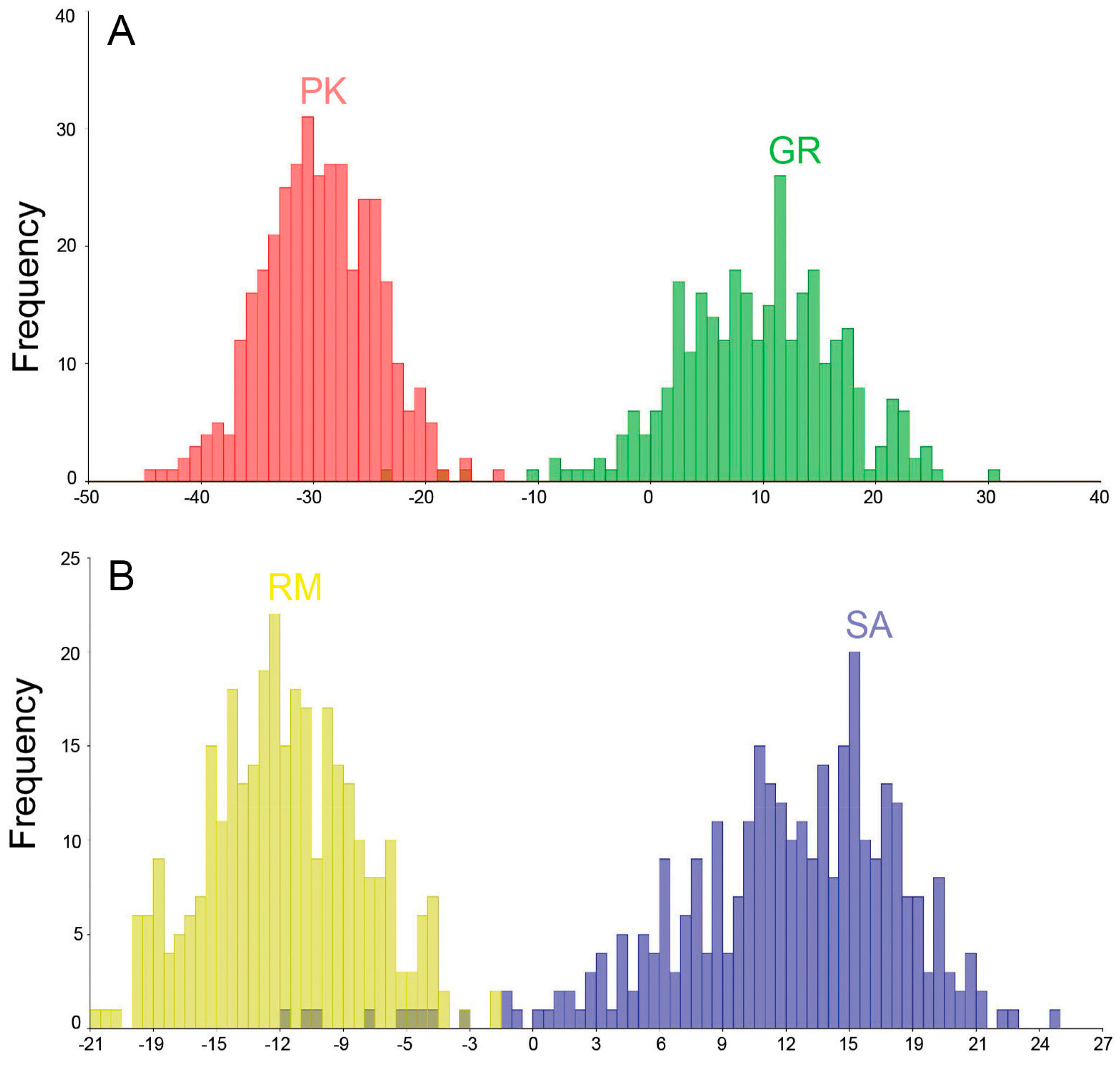
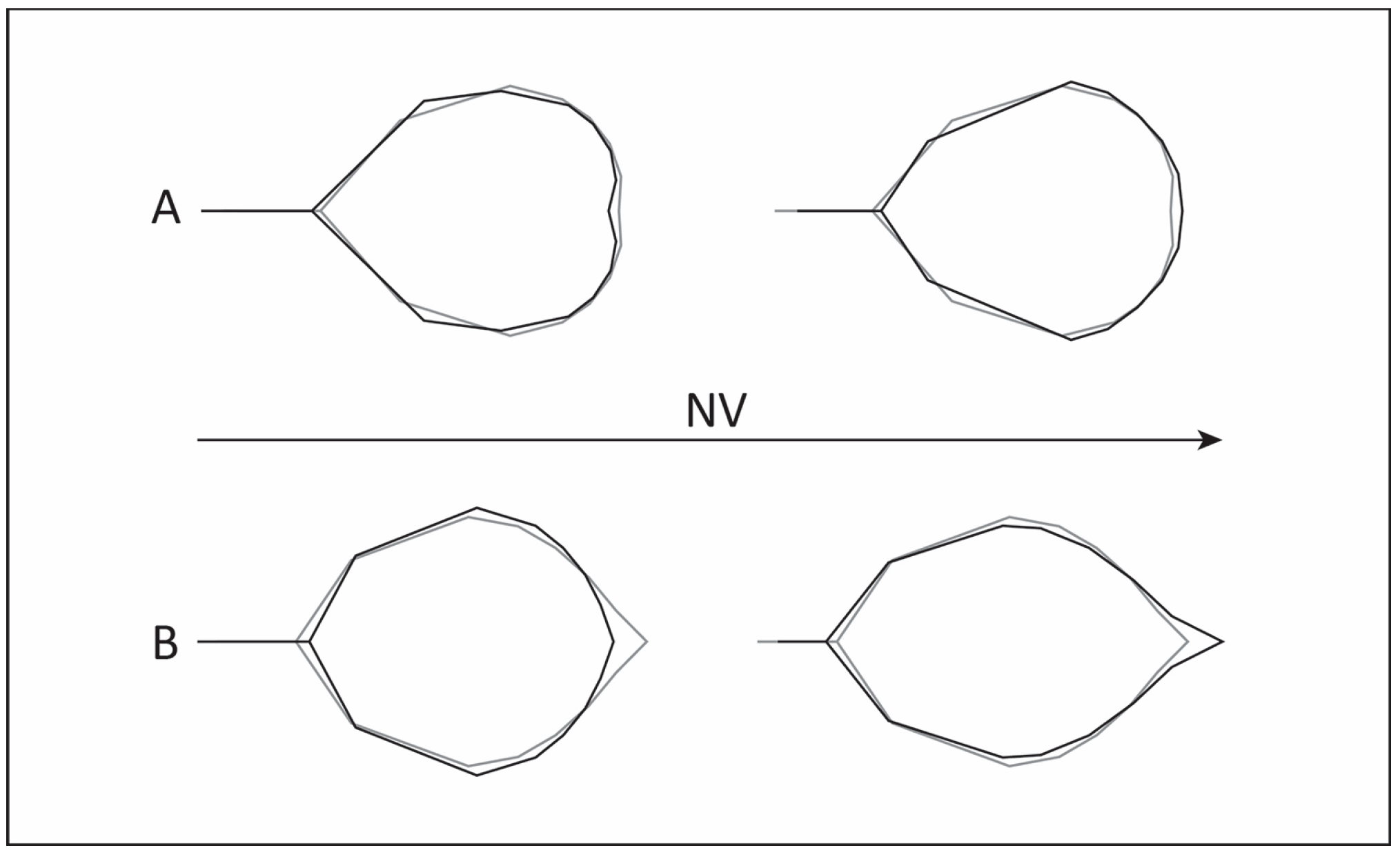
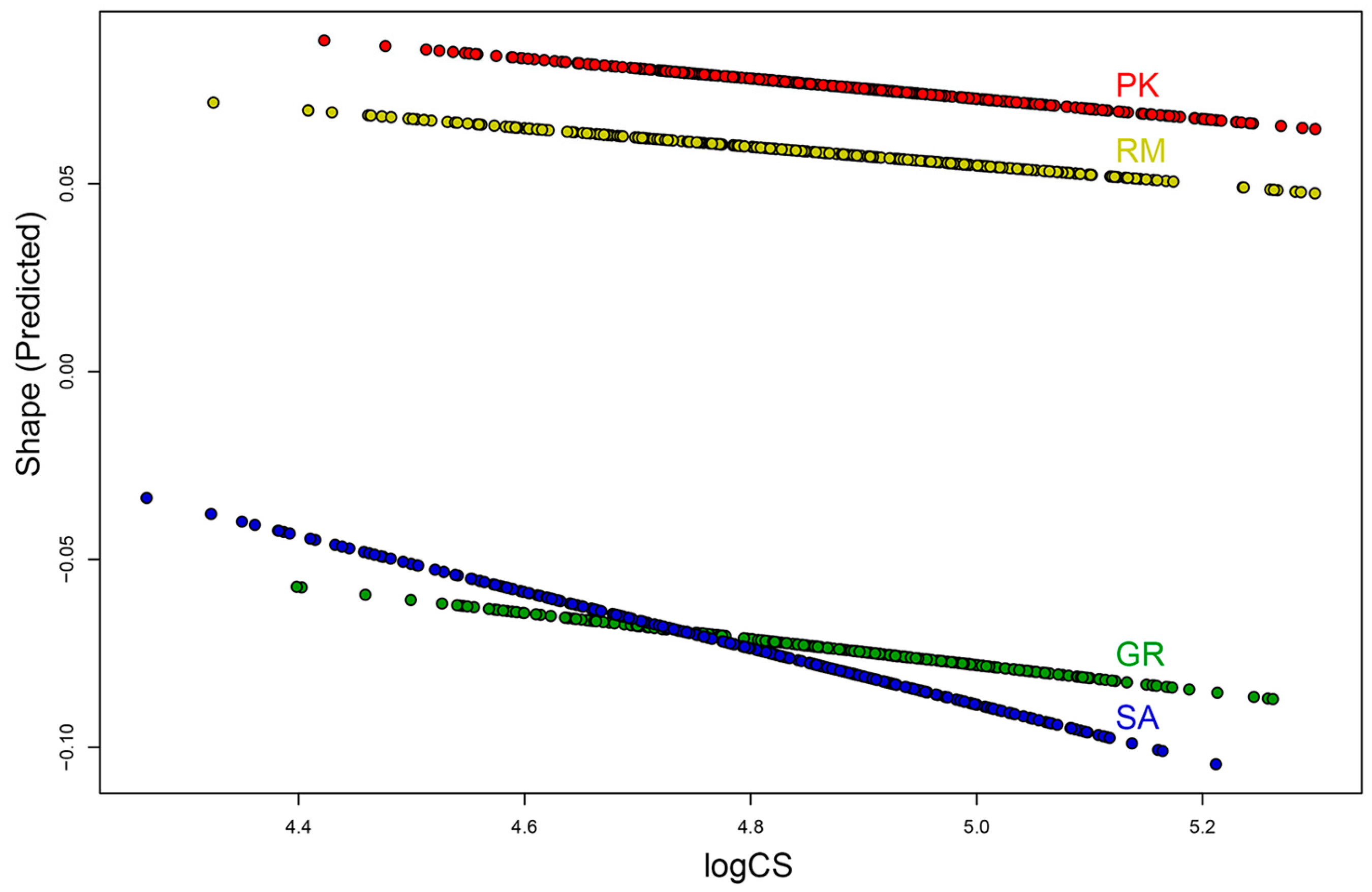
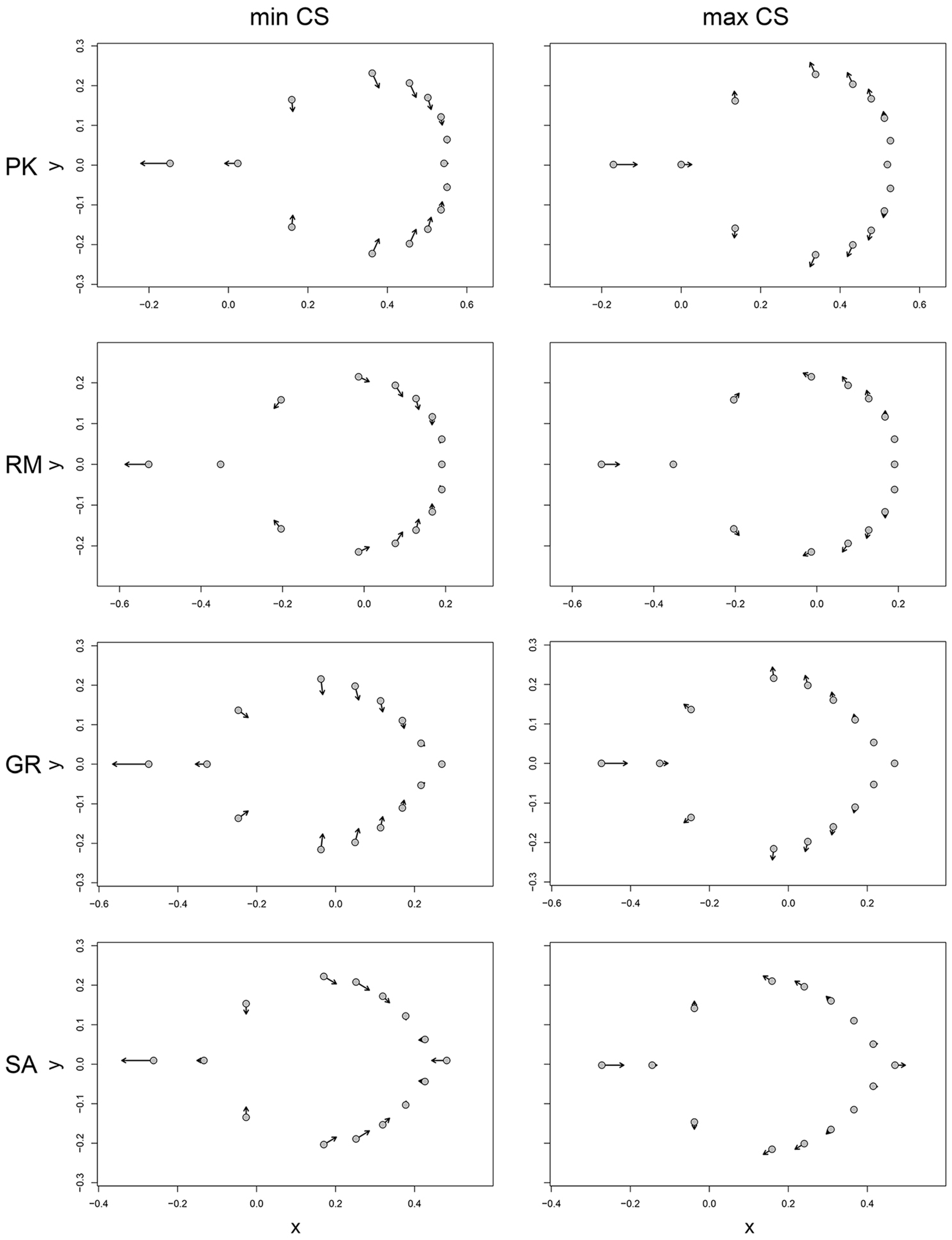
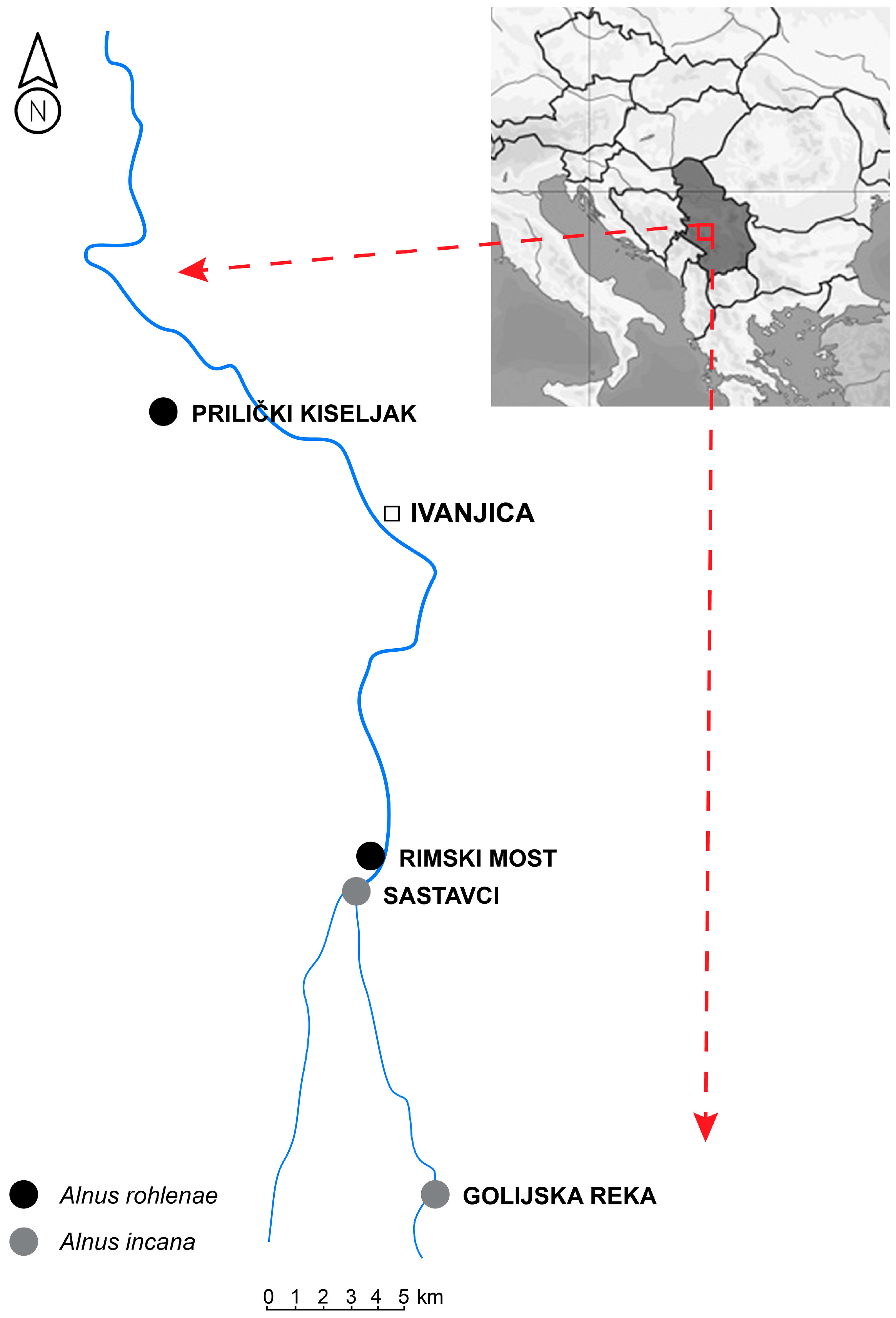

| PK | RM | GR | SA | |
|---|---|---|---|---|
| Mahalanobis distances | ||||
| PK | <0.0001 | <0.0001 | <0.0001 | |
| RM | 1.3806 | <0.0001 | <0.0001 | |
| GR | 5.3880 | 5.1616 | <0.0001 | |
| SA | 5.4879 | 5.1940 | 1.3680 | |
| ΣM | 12.26 | 11.74 | 11.92 | 12.05 |
| Procrustes distances | ||||
| PK | <0.0001 | <0.0001 | <0.0001 | |
| RM | 0.0378 | <0.0001 | <0.0001 | |
| GR | 0.1476 | 0.1329 | <0.0001 | |
| SA | 0.1485 | 0.1308 | 0.0275 | |
| ΣP | 0.33 | 0.30 | 0.31 | 0.31 |
| Reference | Country/Region | Sample Size | Alnus glutinosa | Alnus incana | A. × pubescens | Alnus rohlenae | ||||
|---|---|---|---|---|---|---|---|---|---|---|
| Range | Mean | Range | Mean | Range | Mean | Range | Mean | |||
| Present study | Southwestern Serbia | 1315 | – | – | 7–15 | 10.7 | – | – | 4–10 | 6.9 |
| [7] | Central Poland | ≈1000 | – | 6.4 | – | 11.16 | – | 8.77 | – | – |
| [12] | Europa | ≈350 | 6–9 | 7.5 | 8–14 | 11 | – | – | 7–10 | 8.2 |
| [14] | West Siberia Russia Czech Republic | 7500–10,000 | 6–8 | 6.5 | 9–15 | 12 | 9–10 | 9.7 | ||
| [15] | Lithuania | 960–1920 | 5–9 | 7.21 | 8–12 | 10.04 | 6–10 | 8.17 | – | – |
| [16] | Bosnia and Herzegovina | 275 | 6–9 | 7.3 | 9–13 | 11.1 | 6–10 | 8.9 | – | – |
| [18] | Ireland | ≈1700 | 4–7 | 6 | 10–15 | ≈10 | – | ≈10 | – | – |
| [19] | Northern Croatia | 2000 | – | 6.61 | – | 11.08 | – | 8.68 | – | – |
| [38] | Balkan Alpine Giant Mountains East and West Carpathians Central European Lowlands Northern Scandinavia | 7200 | – | – | 5–18 | 11.15 | – | – | – | – |
| Total Number of Sampled Leaves | Range | Mean NV | Mean CS | |
|---|---|---|---|---|
| PK | 367 | 4–9 | 6.926 d | 134.705 a |
| RM | 321 | 5–10 | 6.874 d | 131.559 a |
| GR | 306 | 7–14 | 10.464 b | 135.156 a |
| SA | 303 | 8–15 | 11.032 a | 124.786 b |
| PH | 18 | 8–11 | 9.487 c | 117.684 b |
| Species | A. rohlenae | A. incana | ||
|---|---|---|---|---|
| Locality name | Prilički kiseljak | Rimski most | Golijska reka | Sastavci |
| Population | PK | RM | GR | SA |
| Latitude (N) | 43°36′55″ | 43°28′09″ | 43°21′46″ | 43°27′38″ |
| Longitude (E) | 20°08′04″ | 20°14′05″ | 20°15′26″ | 20°13′22″ |
| Altitude (m) | 565 | 655 | 1396 | 670 |
| Nt | 21 | 20 | 20 | 21 |
| Nl | 367 | 321 | 310 | 317 |
| MAT a (°C) | 9.7 | 6.6 | 5.0 | 6.5 |
| AP a (mm) | 776.8 | 797.1 | 842.2 | 797.1 |
| HTC a | 1.43 | 1.73 | 1.94 | 1.73 |
| Effect | SS | MS | df | F | p | Pillai’s Trace | p | ||
|---|---|---|---|---|---|---|---|---|---|
| PK | Shape | Tree | 0.293755 | 0.005649 | 52 | 5.65 | <0.0001 | ||
| Leaf | 0.584867 | 0.001000 | 585 | 2.13 | <0.0001 | ||||
| Side | 0.005854 | 0.000450 | 13 | 0.96 | 0.4893 | ||||
| Ind. × Side | 0.298646 | 0.000469 | 637 | 9.34 | <0.0001 | 10.26 | <0.0001 | ||
| Error | 0.065281 | 0.000050 | 1300 | ||||||
| Size | Tree | 10928.22 | 2732.055 | 4 | 2.36 | 0.0676 | |||
| Leaf | 52120.68 | 1158.237 | 45 | 1891.58 | <0.0001 | ||||
| Error | 30.66 | 0.612 | 50 | ||||||
| RM | Shape | Tree | 0.066867 | 0.001286 | 52 | 1.29 | 0.0927 | ||
| Leaf | 0.585397 | 0.001001 | 585 | 2.38 | <0.0001 | ||||
| Side | 0.006036 | 0.000464 | 13 | 1.10 | 0.3537 | ||||
| Ind. × Side | 0.268360 | 0.000421 | 637 | 14.54 | <0.0001 | 10.32 | <0.0001 | ||
| Error | 0.037669 | 0.000029 | 1300 | ||||||
| Size | Tree | 12009.60 | 3002.399 | 4 | 4.35 | 0.0047 | |||
| Leaf | 31092.41 | 690.9424 | 45 | 1781.44 | <0.0001 | ||||
| Error | 19.39 | 0.39 | 50 | ||||||
| GR | Shape | Tree | 0.061717 | 0.001187 | 52 | 1.36 | 0.0503 | ||
| Leaf | 0.508741 | 0.000870 | 585 | 2.32 | <0.0001 | ||||
| Side | 0.007718 | 0.000594 | 13 | 1.58 | 0.0849 | ||||
| Ind. × Side | 0.238823 | 0.000375 | 637 | 10.23 | <0.0001 | 10.63 | <0.0001 | ||
| Error | 0.047628 | 0.000037 | 1300 | ||||||
| Size | Tree | 6393.46 | 1598.365 | 4 | 2.36 | 0.0675 | |||
| Leaf | 30476.39 | 677.253 | 45 | 657.89 | <0.0001 | ||||
| Error | 51.47 | 1.02 | 50 | ||||||
| SA | Shape | Tree | 0.085481 | 0.001644 | 52 | 2.07 | <0.0001 | ||
| Leaf | 0.464716 | 0.000794 | 585 | 1.75 | <0.0001 | ||||
| Side | 0.004803 | 0.000369 | 13 | 0.81 | 0.6449 | ||||
| Ind. × Side | 0.288919 | 0.000454 | 637 | 8.57 | <0.0001 | 10.51 | <0.0001 | ||
| Error | 0.068766 | 0.000053 | 1300 | ||||||
| Size | Tree | 10267.96 | 2566.990 | 4 | 7.63 | <0.0001 | |||
| Leaf | 15133.74 | 336.305 | 45 | 1299.75 | <0.0001 | ||||
| Error | 12.94 | 0.259 | 50 |
Disclaimer/Publisher’s Note: The statements, opinions and data contained in all publications are solely those of the individual author(s) and contributor(s) and not of MDPI and/or the editor(s). MDPI and/or the editor(s) disclaim responsibility for any injury to people or property resulting from any ideas, methods, instructions or products referred to in the content. |
© 2024 by the authors. Licensee MDPI, Basel, Switzerland. This article is an open access article distributed under the terms and conditions of the Creative Commons Attribution (CC BY) license (https://creativecommons.org/licenses/by/4.0/).
Share and Cite
Marković, M.; Vidaković, V.; Popović, Z. A Geometric Morphometrics Approach to the Study of Natural Variations and Hybrid Detection in Populations of Alnus incana (L.) Moench and Alnus rohlenae Vít, Douda and Mandák. Plants 2024, 13, 993. https://doi.org/10.3390/plants13070993
Marković M, Vidaković V, Popović Z. A Geometric Morphometrics Approach to the Study of Natural Variations and Hybrid Detection in Populations of Alnus incana (L.) Moench and Alnus rohlenae Vít, Douda and Mandák. Plants. 2024; 13(7):993. https://doi.org/10.3390/plants13070993
Chicago/Turabian StyleMarković, Milena, Vera Vidaković, and Zorica Popović. 2024. "A Geometric Morphometrics Approach to the Study of Natural Variations and Hybrid Detection in Populations of Alnus incana (L.) Moench and Alnus rohlenae Vít, Douda and Mandák" Plants 13, no. 7: 993. https://doi.org/10.3390/plants13070993
APA StyleMarković, M., Vidaković, V., & Popović, Z. (2024). A Geometric Morphometrics Approach to the Study of Natural Variations and Hybrid Detection in Populations of Alnus incana (L.) Moench and Alnus rohlenae Vít, Douda and Mandák. Plants, 13(7), 993. https://doi.org/10.3390/plants13070993





